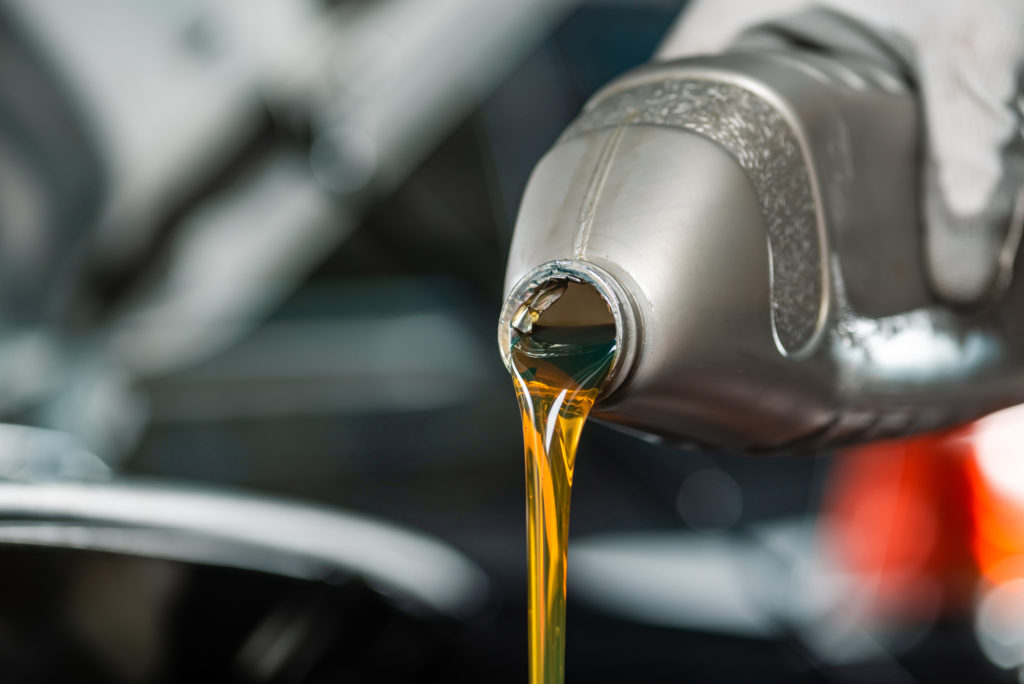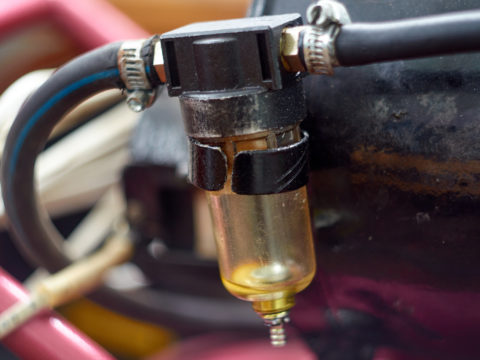Have you ever been confused about what kind of oil is best for your vehicle or wondered what the difference between 5w30 and 10w30 could be?
Keep reading to learn what those letters and numbers mean and which motor oil you should use in summer or winter.

Contents
Is There a Big Difference Between 5w30 and 10w30?
There isn’t a big difference between 5w30 and 10w30, but they have different viscosities.
5w30 oil has a lower viscosity than 10w30, making it slightly thinner. The lower viscosity makes 5w30 a better choice in cold weather.
Viscosity is the level of a liquid’s resistance to flow. Thin liquids that flow easily, like water, have low viscosity. Thicker liquids, like molasses, have high viscosity and pour slowly. More than measuring thickness, viscosity measures the liquid’s resistance to change based on its structure.
Each oil’s name comes from its viscosity. For instance, the W in both oils stands for winter. The number before the W is the viscosity grade during winter or cold weather. The number after the W represents the viscosity at average operating temperatures.
5w30 has a viscosity grade of 5, while 10w30 has a viscosity grade of 10. Since both oils have the same number after the W, sometimes called the hot viscosity grade, they operate the same at higher temperatures.
Both oils lubricate engine parts to keep the system running smoothly. Though they operate at the same weight of oil at higher temperatures, the differences in their thickness make one a little better for hot weather than the other.
Likewise, the difference in their cold viscosity number means one of them is better in cold weather, too.
5w30 and 10w30 Differences Explored
Let’s look at each type of oil in detail to see what each one does best and how they compare.
Notable 5W-30 Oil Features
5w30 is a multigrade oil, meaning it has a different viscosity grade at lower temperatures than higher temperatures. As a result, it’s suitable for most vehicles, including some light-duty diesel engines.
Now, let’s look at some of the features that set 5w30 apart from other motor oils.
What Is 5W-30 Oil Used For?
5w30 has lower viscosity at cold temperatures, and because it’s thinner than 10w30, it will flow better inside the engine and provide better lubrication during the winter months.
Overall Performance
One benefit of 5w30 is that not only does it perform well in freezing temperatures, but it also stands up to heat. If you put 5w30 in your car through the winter, you don’t have to change to a different oil when summer hits.
The oil is thinner than 10w30, so it coats and lubricates better and can make vehicles more fuel-efficient.
Composition
Traditional oil is primarily a petroleum product, but most 5w30 sold today is synthetic. Synthetic oil still has a crude oil base with broken-down petroleum molecules and chemical additives.
Oil Pressure
Lower viscosity oils can reduce the oil pressure in an engine. You can expect a lower pressure when switching to a thinner oil like 5w30 that flows easier than oil like 10w30.
Viscosity
5w30 has a cold viscosity grade of 5, which means that in cold temperatures, it flows like a 5-weight oil or a thinner oil than 10w30, which has a grade of 10.
The oil has a hot viscosity grade of 30 which means it flows like a 30-weight oil when the engine temperature is warmer.
Operating Temperature
5w30 oil operates well in temperatures ranging from -22 degrees to 95 degrees Fahrenheit. However, if the weather stays above 95 degrees, oil with a higher hot viscosity number can be a better choice.
Mileage
Using a lower viscosity oil like 5w30 can increase the gas mileage on your vehicle by lubricating the engine better on start-up in colder temperatures and making it more efficient.
Also, some types of 5w30 for high-mileage vehicles help lubricate older engines and delay wear and tear that causes breakdowns.
Some experts recommend 10w30 for high-mileage vehicles because the thickness helps protect and seal, but some high-mileage 5w30 brands work to protect older engines, especially in cold temperatures.
Price Per Quart
Most 5w30 oil ranges from about $3.50 to over $5 per quart, with some specialty blends for high-mileage engines closer to $7 or more per quart.
Notable 10W-30 Oil Features
Since 10w30 has a higher viscosity than 5w30, it’s thicker and flows slower during cold weather. The thickness gives it more staying power between engine parts at higher temperatures.
What is 10W-30 Oil Used For?
10w30’s thickness makes it suitable for heavier-duty engines. What it lacks in the ability to coat well during cold-weather starting, it makes up for it by providing better lubrication and sealing properties.
Overall Performance
10w30 performs well in a wide range of temperatures, though it’s better for warmer weather than colder temperatures. In addition, the thicker viscosity can help older and high-mileage engines last longer by providing thorough lubrication and possibly stopping small leaks.
The thicker oil is suitable for heavy-load engines because it sticks better between the engine elements and reduces friction in ways thinner oils can’t.
Composition
10w30 comes in a conventional form known as mineral oil and in synthetic forms, like 5w30. The synthetic oils still have a crude oil base with additives designed to provide superior lubrication over conventional petroleum oils.
Oil Pressure
Using 10w30 in cold weather can cause higher oil pressure until the engine warms up. However, a higher cold viscosity oil like 10w30 can also cause lower pressure if it isn’t flowing well and lubricating properly.
Viscosity
10w30 has a winter viscosity of 10, so it flows like a 10-weight oil in colder weather. However, at normal engine temperatures, the viscosity is 30, so it flows like a 30-weight oil in warmer temperatures.
Operating Temperature
10w30 operates between -13 degrees to about 90 degrees Fahrenheit, though 5w30 is better for colder temperatures, particularly those close to 0 degrees Fahrenheit.
This oil will still work in colder temperatures, but it can’t lubricate the engine quickly because it’s much thicker when cold than oil like 5w30.
Mileage
0w30 can provide superior lubrication to older engines with higher mileage. Older engines suffer more from friction than newer ones, but thicker oils like 10w30 help keep parts running together smoothly.
This oil’s thicker consistency can also help prevent leaks in some cases.
Price Per Quart
The cost of 10w30 isn’t much different than the cost of 5w30. The price per quart starts at around $3.50. Depending on the brand and additives, the cost can go up to several dollars per quart.

Pros and Cons of 5W-30 and 10W-30 Oil
Both oils are suitable for regular use in most day-to-day driving situations and vehicles, but let’s look at the pros and cons of each type.
| 5w30 | 10w30 | ||
| Pros | Cons | Pros | Cons |
| Coats faster at lower temperatures | It might be too thin for heavy-duty engines | The thickness provides better lubrication | It can’t lubricate well at cold temperatures |
| Works in a wide range of temperatures | Not the best for stop-and-go traffic | Can help stop or slow leaks | Too thick for extremely hot weather |
| Best for standard passenger vehicles and light-duty diesel engines | Better oils exist for extremely hot weather | Better for engines hauling heavy loads |
When to Use 5W-30 Oil
Use 5w30 oil when the temperatures dip. If you encounter any wintertime temperatures, whether you’re in an area that hits 20 below or in a temperature region where cold-weather temperatures still hit 70 or 80 degrees, 5w30 will work well.
The only time you’d need to use a different oil would be at extremely hot temperatures or in an older engine that needs a thicker oil for better lubrication.
When to Use 10W-30 Oil
Use 10w30 for heavy-duty hauling and engines that have to work especially hard, and in older engines that need thicker oil for lubrication. You can use this oil in the winter, but save it for the warmer months if the temperature regularly dips below freezing.
How Do You Know Which Oil is Good for Your Car?
Your vehicle’s owner’s manual will recommend the oil’s viscosity rating that’s best for your car.
Our Recommended 5w30 and 10w30 Oil Brands
Some of the best brands of full synthetic 5w30 motor oil include:
- Castrol GTX Magnatec
- Pennzoil Platinum
- Valvoline Advanced
The top brands of 10w30 motor oil we recommend include:
- Quaker State Advanced Durability
- Mobil 1 Extended Performance High Mileage
- Castrol Edge High Mileage
FAQs
Now that you are familiar with the differences between 5w30 vs. 10w30 oil, let’s wrap up with some frequently asked questions about the two types of oils.
Can you mix 5w30 and 10w30?
You can mix 5w30 and 10w30. The hot viscosity, the 30 grade, will stay the same if you mix them. However, the cold weather viscosity grade will increase, making it less desirable for cold temperatures than 5w30 on its own.
There’s no reason to mix them, but if you have one in your engine and need to add oil before you can get more of the same kind, it’s perfectly fine to add one to the other unless the temperature is below 0 degrees Fahrenheit.
All mixing does is reduce the best qualities of each oil, so if you can avoid mixing them, you should.
Can I add 5w30 to 5w20 safely for a short time before an oil change?
Yes, you can combine these two oils in your engine briefly without problems. However, keep in mind that if the temperatures reach either cold or hot extremes, you’ll be reducing the oil’s normal ability to work well in those temperatures.
5w20 is a thinner oil, and even though it has the same cold viscosity grade as 5w30, its consistency makes it stand up to even colder temperatures than 5w30. You reduce that cold-weather ability by at least a little if you mix them.
You’ll also reduce the 5w30’s ability to stand up to hotter temperatures because 5w20’s top optimal operating temperature is less than 5w30’s.
Like with mixing 5w30 and 10w30, you shouldn’t if you don’t have to, but doing so for a while won’t make a big difference in your vehicle’s performance.
Is 5w30 or 10w30 better for summer?
You can use either oil during summer temperatures, but some experts recommend using 10w30 for the protection of the slightly thicker oil that won’t run off engine parts as quickly.
Is 10w30 or 5w30 better for winter?
5w30 is the better oil for winter temperatures, especially when the temperature hits freezing or below. This oil can provide faster, better lubrication to about -22 degrees Fahrenheit, while a thicker oil like 10w30 moves too sluggish at slow temperatures to provide enough protection.














